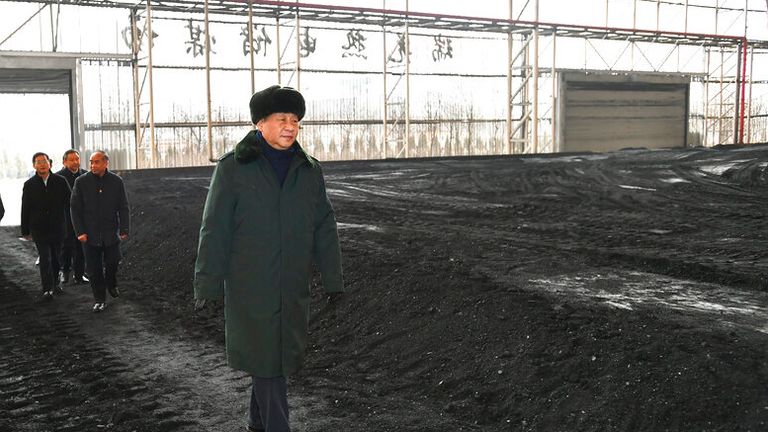China ramped up coal power capacity last year, according to new analysis, despite a pledge to “strictly control” the dirtiest fossil fuel.
The country added 47.4 Gigawatts (GW) of new coal power in 2023, more than double the amount added by the rest of the world combined.
It raises concerns that gains in clean power, including by China, are being undermined by the persistent use of coal, the worst energy form for climate change and air pollution.
Analysts say China may not use all the capacity it has built.
Beijing has promised to reduce coal consumption from 2026, and said its polices align with the international Paris Agreement on climate.
But the surge drove an increase in global coal by 2% last year, the first uptick since 2019, though other countries were responsible too, Global Energy Monitor (GEM) said.
The global rise comes two years after countries promised at the COP26 climate conference in Glasgow to “transition away” from coal.
GEM said it could just be a “blip”.
But Tina Stege, climate envoy for the Marshall Islands, which are battling rising sea levels, said fossil fuel support is “unacceptable”.
Professor Piers Forster, interim chair of the UK government’s Climate Change Committee, called it “worrying”.
While extra capacity may not end up being used, “without strong regulation and polices that prevent it from being used, 2023 will not be seen as just a blip and future emissions rise will be inevitable”, Prof Forster said.
Does China need more coal power?
China’s coal spree is “very out of line” with a promise made by President Xi in 2021 to “strictly control” new coal power, said Flora Champenois, GEM coal programme director.
It also threatens a Chinese Communist Party target to shut down 30GW of coal power by 2025 – with only 9GW retired in the last few years.
“This coal boom – in terms of new coal plants coming online, new permits being awarded, new construction starting, no signs of a slowdown, no signs of retirement on the horizon – does not align with the commitment to strictly control coal,” Ms Champenois told Sky News.
But the new coal plants do “not necessarily mean that China is going to increase an equivalent scale of CO2 emissions,” said Qi Qin, China analyst for Research on Energy and Clean Air, who also wrote the report.
That’s because China is “increasing its renewable power capacities by [the same] scale too”, she said.
China has recently built more solar power than the rest of the world combined, and is on track to meet a 2030 clean power goal five years early.
The surge is partly fuelled by power shortage fears after a 2022 drought shrivelled water supplies for China’s hydropower.
But it already has more coal power than it needs, said Ms Qin, but a rigid grid system makes it hard for provinces to share power, meaning many are building their own coal plants.
‘Blip’ or ‘unacceptable’?
Seven other countries added new coal power in 2023 too, GEM found.
Those were Indonesia, India, Vietnam, Japan, Bangladesh, Pakistan, South Korea, Greece, and Zimbabwe.
But GEM also partly blamed the global net increase in coal power on rich countries stalling plant closures amid the energy crisis in 2022.
Marshall Islands climate envoy Tina Stege, said: “We can’t afford blips.”
She told Sky News: “Since the start of the year, my country has been reeling from one climate-induced emergency to another, with flooding from king tides and drought affecting communities throughout the islands.”
Coal power, still the single largest source of emissions globally, must be “phased out as soon as possible” to avoid “catastrophic sea level rise and [save] lives and livelihoods”, she said.
She called it “unacceptable” the world has hardly started on shifting the trillion dollar subsidies for the fossil fuel industry to clean alternatives.
A spokesperson from the Chinese embassy in London said China will go from peaking emissions to carbon neutrality “in the shortest span of time ever in the world”.
“Our climate policies and objectives are fully consistent with the long-term temperature goal of the Paris Agreement.
“Today, close to half of the world’s installed [solar PV] capacity is in China, over half of the world’s new energy vehicles run on roads in China, and one-fourth of the world’s increased area of afforestation is in China.”
They added: “We are also working to cultivate large-scale new growth drivers in green infrastructure, green energy, green transportation and green lifestyle.”

